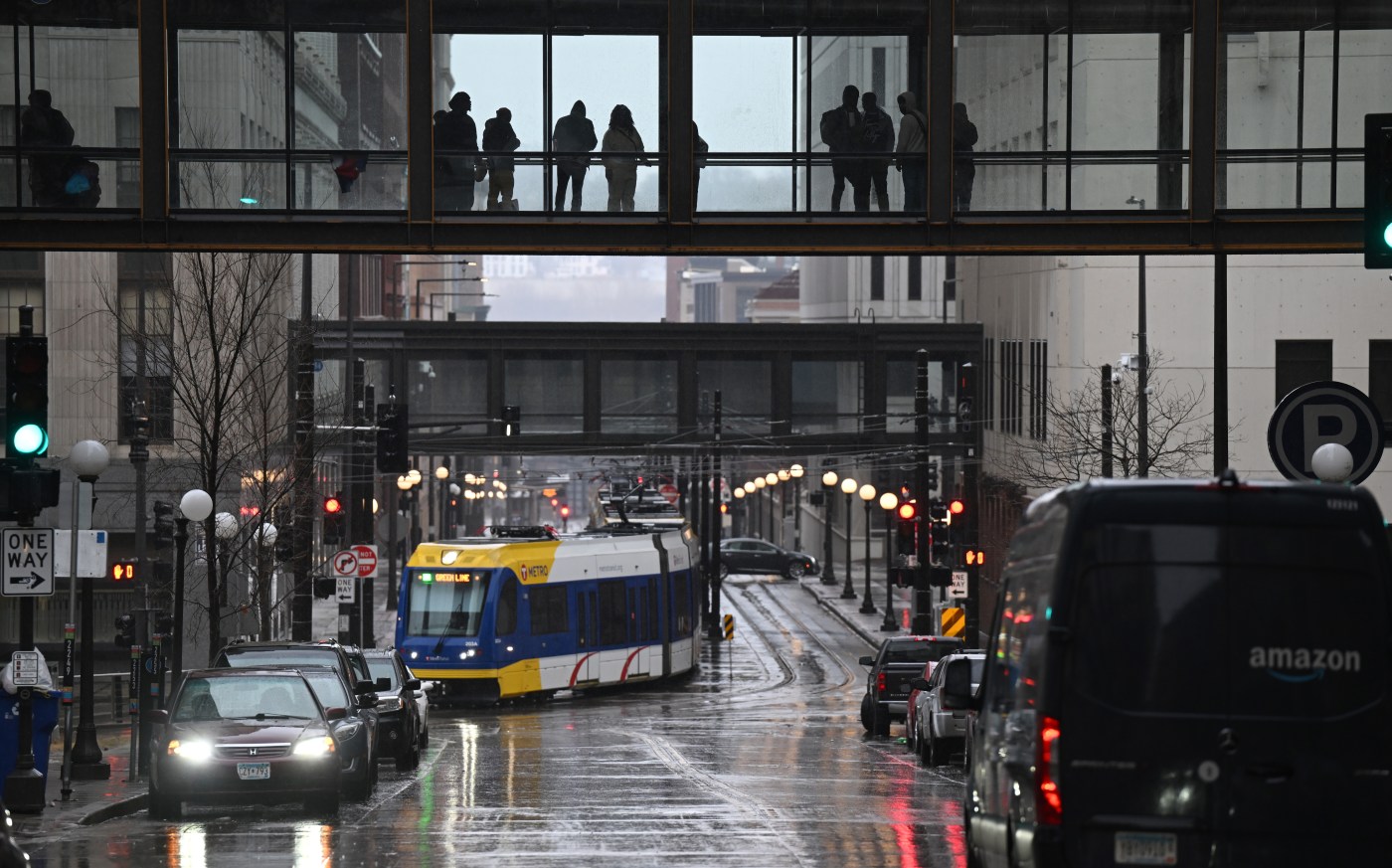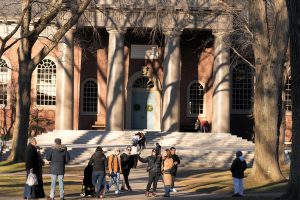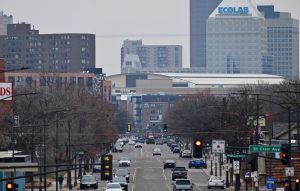
Amidst office upheaval, vendors, business advocates, leaders weigh in on future of downtown St. Paul
Weeks before the pandemic swept into Minnesota, Rico Thomas opened a ground-level ice cream shop in downtown St. Paul’s Alliance Bank Center on Wabasha Street, hopeful he’d soon be scooping cones to passersby at a rapid clip. Then the opposite happened. Office tenant after office tenant turned to remote work, forcing him to close down shop for a time while other vendors called it quits entirely.
The iconic “1st” sign atop First National Bank Building in downtown St. Paul. (Gabriel Sanchez / Pioneer Press)
Thomas, who later reopened Rico’s on Wabasha, has kept the faith, recently adding a wide variety of breakfast tacos, sandwiches and diner foods to his menu. With his best friend Redd Barnes manning his primary site, he’s even thinking of expanding into a second downtown location, if he can find one, and rolling an ice cream cart through downtown Pride events or partnering with the Minnesota Wild on food discounts.
Still, even Thomas was taken aback to learn in recent days that building owner Jim Crockarell — principal of Madison Equities — had died in January and that his widow has put the Alliance Center and five other office buildings on the market.
“Downtown St. Paul has a lot of potential, but I feel like the momentum is slipping,” said Thomas, a father of three young kids, eying the stark quiet of the hallway around him on Friday morning.
Diehard skyway vendors have expressed frustration with what some describe as off-again, on-again support from City Hall in light of a downtown office market shaken by the pandemic and the post-pandemic era of remote work.
Many state, city and county municipal offices — as well as the regional Metropolitan Council — have consolidated workspaces or gone fully remote, as much if not more so than their private-sector counterparts.
Bilal Salim, who has been cutting hair at multiple venues downtown for 20 years under the name Mr. B., mused Friday that he might look into relocating from the Alliance Center into the Town Square complex on Cedar Street.
Then Salim learned that within months, Town Square’s UBS Plaza will be losing a major tenant. Design and engineering firm TKDA announced Thursday it will leave St. Paul — where it was founded in 1910 — and relocate to an existing office building on Old Shakopee Road in Bloomington in early 2025, taking some 300 downtown employees with it.
U.S. Bank recently announced a similar exit from the U.S. Bank Building downtown to St. Paul’s West Side.
“I don’t know how you’re going to bring the businesses back,” said Salim, who has advocated for greater law enforcement presence in the skyways. “We need to do something to bring downtown back — something.”
An ‘All In’ housing strategy
The amount of shifting in the downtown office market — as well as a series of multi-family apartment buildings downtown that just went up for sale — has been little short of startling for some observers. A year ago, Tina Gassman, president of the Greater St. Paul Building Owners and Managers Association, would have said that about 80% of the “competitive,” or private sector office space downtown was occupied.
Given the pending upheaval, these days, it’s anyone’s guess.
“I’ve been in this position for just under two years, and this is multiplied times 10 what I’ve seen in those two years,” said Gassman on Friday.
When asked about Mayor Melvin Carter’s reaction to TKDA leaving, the mayor’s office issued a written statement on Friday, attributed to the mayor:
“TDKA has played a pivotal role in the success of our downtown for over a century … We are grateful for our longstanding partnership, and we wish them well as they continue serving our community and communities across the nation.”
Still, Nicolle Goodman, the director of the city’s Department of Planning and Economic Development, recently talked up what the mayor has called his “All In” housing strategy. In his state-of-the-city address last March, Carter floated the possibility of filling dated, underused office space downtown with conversions to residences.
The mayor at the time raised the likelihood that the City Hall annex building on Fourth Street could be sold for housing, which would help fill in empty spaces elsewhere downtown with relocated city departments.
Developers and real estate lenders have noted that converting 50-year-old, 70-year-old and century-old office buildings is trickier and costlier than it sounds, in part because each housing unit will need its own bathroom. With the goal of preservation in mind, a bill at the state Legislature introduced in late March offers a tax credit covering up to 30% of the cost of an office-to-housing conversion, provided that the project retains about 75% of the existing structure.
The bill, sponsored by state Sen. Matt Klein, DFL-Mendota Heights, and state Sen. Scott Dibble, DFL-Minneapolis, was heard by the Senate committee on taxes in early April, but its chances of being approved before lawmakers adjourn are up in the air.
“We’re still hopeful,” said St. Paul Deputy Mayor Jaime Tincher, in an interview Friday. “That tax credit for office-to-housing conversions, that’s really critically needed from the state. To incentivize developers to look at those properties and take advantage of that opportunity, having the tax credit for that conversion would be helpful.”
The Downtown Alliance’s Downtown Investment Strategy
Still, new housing units on the market would find they have competition, as a flurry of residential buildings downtown have hit the market in the past month, most of them within the past 10 days. They include Madison Equities’ Lowry Apartments at Fourth and Wabasha streets, which is being marketed separately from the company’s commercial buildings, as well as The Lofts at 262 Fourth St. E. and the R7 Lofts at 133 E. Seventh St. Elsewhere in the city, the C&E Living Apartments at 2410 University Ave. W. in South St. Anthony Park are also up for sale.
Then there’s the difficult backdrop of high interest rates and the city’s projected population growth, which has slowed, as well as some St. Paul policy decisions unpopular with the private sector, such as rent control, which took effect in 2022 before a major revision took hold last year.
Joe Spencer, president of the St. Paul Downtown Alliance — a partnership between City Hall and major employers such as Securian and Ecolab — said the writing has been on the wall when it comes to commercial tenants itching to leave aged office space in the era of remote work.
A Downtown Investment Strategy unveiled by the alliance in March emphasizes the importance of three key strategies, including office-to-residential conversions and improving the pedestrian streetscape on a handful of key connecting corridors that cross downtown, such as Fifth Street, Kellogg Boulevard, Wabasha Avenue and Robert Street.
The 125-page strategy, prepared by a downtown steering committee with the help of New York-based consultants, also calls for “activating” the dead space around downtown Central Station, the future RiversEdge project along Kellogg Boulevard and the Xcel Energy Center with new public-facing development and amenities.
“Markets are cyclical,” Spencer said on Friday. “Buildings are going to trade. We’re hopeful the Downtown Investment Strategy will help guide what will happen.”
An expanded Downtown Improvement District?
The alliance oversees a Downtown Improvement District that offers street greeters, graffiti removal and other services within the core of downtown, though its coverage area was effectively gerrymandered to avoid Crockarell’s properties in and around Lowertown. That could soon change.
Amendments to state law last year now allow special service districts to assess membership fees to residential buildings, as opposed to just commercial ones. With Madison Equities no longer a key player, that raises the possibility that a future improvement district could encompass all of downtown “and deliver better, more effective programming,” Spencer said. “That creates an opportunity that we’re exploring.”
Perhaps the biggest impact of the improvement district has been on petty crime. Spencer noted that a comparison of crime trends from 2018 to 2020 and 2021 to 2023 found a sharp drop in quality-of-life calls for service within the improvement district, compared to a 25% increase in Lowertown, as well as a sizable uptick in what police dub the “north quadrant” around Wacouta Street.
“Crimes downtown as a whole were flat, but they dropped by 40% within the district,” Spencer said.
Through the brokerage firm CBRE, Madison Equities has made a public call for a single buyer to purchase six downtown office buildings, two parking ramps, the Selby Avenue restaurant The Handsome Hog and the vacant lot next it. Gassman, of the Building Owners and Managers Association, hopes that doesn’t come to pass.
“While that’s probably quicker and easier for them, it’s probably not going to be the most profitable for them,” Gassman said. “You’re going to get a much better deal piecemeal, and also it will be better for the city to get a variety of owners who can work with the city on that Downtown Investment Strategy.”
Related Articles
St. Paul: Degree of Honor Building, Seventh Place Apartments will not go on market at this time
Downtown St. Paul’s Lowry Apartments building, location of Gray Duck Tavern, for sale
A look at the 10 Madison Equities properties for sale in downtown St. Paul
St. Paul City Council votes 3-2 against rezoning for Marshall Avenue townhome project
Downtown developers, advocates weigh in on Madison Equities selling St. Paul properties


